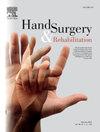Ultrasound-guided radial nerve release for lateral intermuscular septum syndrome
IF 1
4区 医学
Q4 ORTHOPEDICS
引用次数: 0
Abstract
Radial nerve entrapment at the lateral intermuscular septum in the distal upper arm can cause debilitating pain and functional impairment. The nerve passes from the dorsal to the volar compartment through the LIS, approximately 8–10 cm proximal to the lateral epicondyle, making it susceptible to compression. Clinical signs include wrist drop, localized pain, and weakness in wrist and finger extension, often seen in manual laborers and athletes.
A minimally invasive, ultrasound-guided, percutaneous technique using local anesthesia and no tourniquet allows precise nerve decompression while preserving function. Hydrodissection under Doppler ultrasound ensures safety and avoids complications such as nerve palsy. This approach minimizes tissue disruption compared to traditional open decompression. Despite promising results, the technique remains under-researched, with no large-scale clinical trials available. Prospective studies with long-term follow-up are essential to establish the efficacy of this innovative, patient-centered technique.
超声引导下桡神经松解治疗外侧肌间隔综合征。
上臂远端外侧肌间隔膜处的桡神经卡压可导致衰弱性疼痛和功能障碍。该神经从背侧穿过 LIS 到达外侧上髁近端约 8-10 厘米处的伏隔,因此很容易受到压迫。临床表现包括手腕下垂、局部疼痛、手腕和手指伸展无力,常见于体力劳动者和运动员。采用微创、超声引导、经皮技术,使用局部麻醉,不使用止血带,可在保留功能的同时对神经进行精确减压。在多普勒超声下进行的水切割可确保安全,并避免神经麻痹等并发症。与传统的开放式减压术相比,这种方法能最大限度地减少对组织的破坏。尽管效果良好,但对该技术的研究仍然不足,目前还没有大规模的临床试验。要确定这种以患者为中心的创新技术的疗效,必须进行长期跟踪的前瞻性研究。
本文章由计算机程序翻译,如有差异,请以英文原文为准。
求助全文
约1分钟内获得全文
求助全文
来源期刊

Hand Surgery & Rehabilitation
Medicine-Surgery
CiteScore
1.70
自引率
27.30%
发文量
0
审稿时长
49 days
期刊介绍:
As the official publication of the French, Belgian and Swiss Societies for Surgery of the Hand, as well as of the French Society of Rehabilitation of the Hand & Upper Limb, ''Hand Surgery and Rehabilitation'' - formerly named "Chirurgie de la Main" - publishes original articles, literature reviews, technical notes, and clinical cases. It is indexed in the main international databases (including Medline). Initially a platform for French-speaking hand surgeons, the journal will now publish its articles in English to disseminate its author''s scientific findings more widely. The journal also includes a biannual supplement in French, the monograph of the French Society for Surgery of the Hand, where comprehensive reviews in the fields of hand, peripheral nerve and upper limb surgery are presented.
Organe officiel de la Société française de chirurgie de la main, de la Société française de Rééducation de la main (SFRM-GEMMSOR), de la Société suisse de chirurgie de la main et du Belgian Hand Group, indexée dans les grandes bases de données internationales (Medline, Embase, Pascal, Scopus), Hand Surgery and Rehabilitation - anciennement titrée Chirurgie de la main - publie des articles originaux, des revues de la littérature, des notes techniques, des cas clinique. Initialement plateforme d''expression francophone de la spécialité, la revue s''oriente désormais vers l''anglais pour devenir une référence scientifique et de formation de la spécialité en France et en Europe. Avec 6 publications en anglais par an, la revue comprend également un supplément biannuel, la monographie du GEM, où sont présentées en français, des mises au point complètes dans les domaines de la chirurgie de la main, des nerfs périphériques et du membre supérieur.
 求助内容:
求助内容: 应助结果提醒方式:
应助结果提醒方式:


